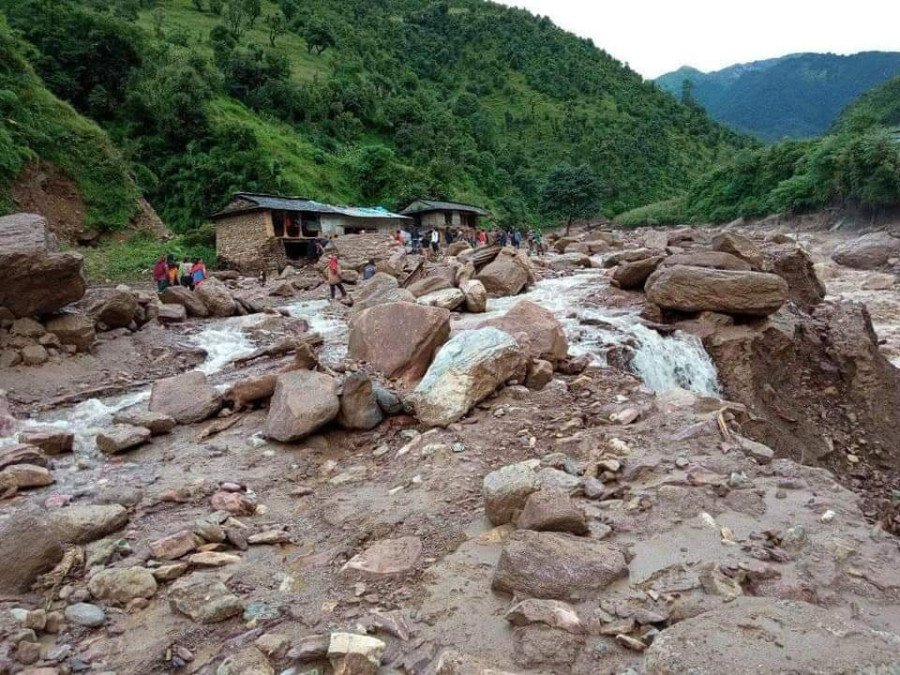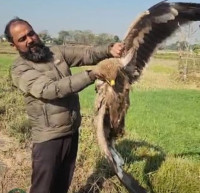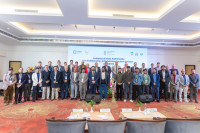National
How politicians' chopper rides to disaster-hit areas fly in the face of spirit of federalism
Leaders and ministers’ penchant for flying to different parts of the country in the name of rescue and relief is reminiscent of the days when the country was under a unitary system.
Anil Giri
On Thursday, an image of Home Minister Ram Bahadur Thapa was widely circulated on social media. The image was taken moments before he boarded a Nepali Army chopper to visit a flood-hit area in Baglung district. Bad weather, however, cancelled his planned trip. Thapa returned to Kathmandu without visiting Baglung.
Earlier in the third week of August, Home Minister Thapa, along with senior Nepal Communist Party leader Bhim Rawal, visited Sainibazaar of Achham district to distribute relief materials to flood-hit locals.
Thapa and Speaker Agni Prasad Sapkota also flew to Sindhupalchok when landslides hit the Lidi village last month.
According to a report in Kantipur, the Post’s sister paper, Thapa and Sapkota over the last three weeks have visited various districts “to inspect” flood- and landslide-hit areas and to distribute relief. The Kantipur report suggests around Rs3.5 million has been spent from the state coffers for chartering the Army’s MI-17 helicopter.
What is more concerning than the money spent on such inspection visits is politicians in Kathmandu are continuing the practice that was prevalent in the Panchayat days, analysts say. Even after practicing multi-party democracy for decades and then the federal democratic system for the last three years, the mindset of the politicians has not changed yet according to them.
“I do not see any point in ministers and leaders from Kathmandu making rounds of every other disaster-hit areas, as provincial and local governments are already in place to respond to such events” said Khimlal Devkota, an expert on federal affairs who also writes extensively on fiscal federalism.
At the federal level there are three different disaster management bodies in place — the Disaster Risk Reduction and Management National Council headed by prime minister, the Disaster Risk Reduction and Management Executive Committee headed by Home Minister and the National Disaster Risk Reduction and Management Authority under the Home Ministry—and the 77 district disaster management committees led by the respective chief district officers.
The Disaster Risk Reduction and Management Act 2017 also envisions Disaster Risk Reduction and Management Provincial Council, Disaster Risk Reduction and Management Provincial Executive Committee in each of the seven provinces and local disaster management committees in the 753 local governments.
Every provincial government also has its own internal affairs ministry.
While there is a worldwide practice of prime ministers or presidents visiting the places hit by a disaster or crisis of a large scale, such events are largely meant to instill the feeling into the citizens that the state is there to support them.
But the way the ministers and politicians from Kathmandu race to visit the disaster-hit sites and distribute relief shows their efforts are just perfunctory, analysts say.
“I do not think our leaders have internalised federalism in true sense,” said Hari Roka, a political economist. “They hardly give a thought to what they should do and what they should not so as to help strengthen federalism. Such visits are largely guided by their desire to display their power and accumulate more power. They just want to centralise authority, which is against the spirit of the federal system.”
After decades of political upheaval, Nepal adopted a new constitution through the Constituent Assembly, a primary demand of the Maoist party that waged the decade-long war against the state. The Maoist leaders said the unitary system of governance and the monarchy were the major hurdle in the country’s socio-political transformation.
Around 13,000 people died and hundreds disappeared during the decade-long war that the Maoists fought to transform Nepal into a federal democratic republic.
After the 2015 constitution ensured Nepal as a federal democratic republic, elections held in 2017 installed three tiers of government across the country–a federal government in Kathmandu, seven provincial governments and 753 local governments.
The biggest bane of the unitary system, according to the proponents of the federal system, was people at the grassroots were always on the margins, as the state largely failed to reach out to them.
Thapa, the current home minister, is among the senior Maoist leaders who said they fought to transform Nepal into a federal state.
In 2017, people’s representatives were elected in 6,473 wards of 753 local bodies across the country to ensure that everyone has their representation in decision-making and that state through its various arms, like wards, will ensure service delivery, promptly respond in the times of crisis and listen to the people’s plight.
With the three tiers of government in place for the last three years, people’s representatives and the federal government should have worked to devolve power and strengthen sub-national governments, according to analysts.
“But politicians in Kathmandu want to centralise power and authority. This shows they want to paralyse federalism,” said Roka. “It is explicitly written in the constitution that the job of the federal government is to facilitate the two tiers of governments and empower them, guide them through the proper policy, among others.”
According to Roka, if a sub-national government lacks funds or resources, the federal government should provide them with resources. “It cannot interfere,” Roka told the Post.
The federal government is already facing criticism for holding on to the concept of chief district officers and making them work as the Home Ministry’s liaison in the districts even in the current federal set-up. Chief district officers’ role has been criticised for undermining the sub-national governments, as they report to the Home Ministry in Kathmandu instead of the provincial internal affairs ministry.
Prime Minister KP Sharma Oli himself has on more than one occasion defied the concept of federalism, saying the sub-national governments are agencies under the federal government and that they are not independent entities. This despite the constitution vesting explicit powers to provincial and local governments to function.
Experts say rescue and relief efforts when a disaster strikes any part of the country require coordinated efforts from all levels of the government.
“The federal government should coordinate with the local governments for rescue and relief efforts,” said Devkota, the expert on federal affairs. “Provincial and local governments are out of business, so the federal government should make them responsible.”
In the past, some provinces have complained about the federal government’s tendency to undermine their authority, but there still seems to be confusion, according to analysts.
Shanta Raj Subedi, a former finance secretary, said that since there is no alternative to federalism, the government has to create bases for fiscal federalism, resources distribution and decentralisation of various resources and it should be done soon rather than later.
“The constitution has explicitly defined how Nepal’s federal system should work. The problem is there is a lack of political will. Politicians in Kathmandu, however, are still functioning with the centralised mindset,” said Subedi. “We have adopted federalism but we are refusing to practice it. Until we realise the fact that power must be delegated and resources must be channelised to the local levels, we cannot have a federal system in true sense.”




 8.12°C Kathmandu
8.12°C Kathmandu















